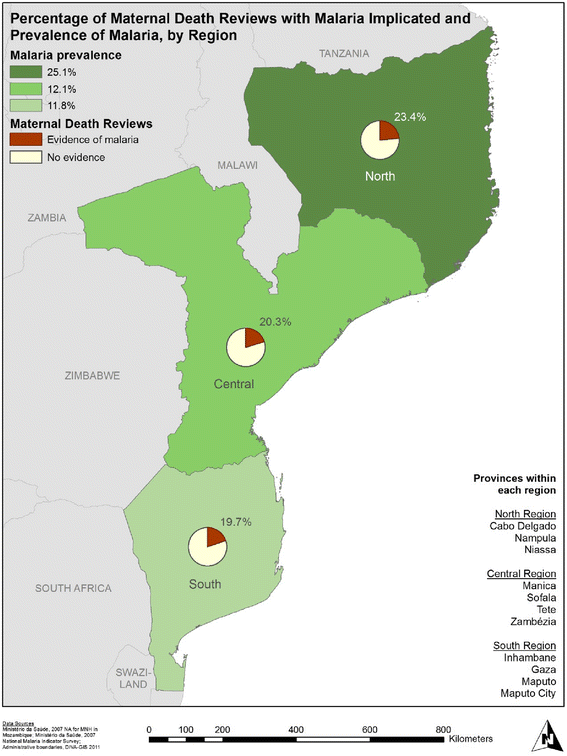The triple threat of pregnancy, HIV infection and malaria: reported causes of maternal mortality in two nationwide health facility assessments in Mozambique, 2007 and 2012
- PMID: 26552482
- PMCID: PMC4640376
- DOI: 10.1186/s12884-015-0725-7
The triple threat of pregnancy, HIV infection and malaria: reported causes of maternal mortality in two nationwide health facility assessments in Mozambique, 2007 and 2012
Abstract
Background: The paper's primary purpose is to determine changes in magnitude and causes of institutional maternal mortality in Mozambique. We also describe shifts in the location of institutional deaths and changes in availability of prevention and treatment measures for malaria and HIV infection.
Methods: Two national cross-sectional assessments of health facilities with childbirth services were conducted in 2007 and 2012. Each collected retrospective data on deliveries and maternal deaths and their causes. In 2007, 2,199 cases of maternal deaths were documented over a 12 month period; in 2012, 459 cases were identified over a three month period. In 2007, data collection also included reviews of maternal deaths when records were available (n = 712).
Results: Institutional maternal mortality declined from 541 to 284/100,000 births from 2007 to 2012. The rate of decline among women dying of direct causes was 66% compared to 26% among women dying of indirect causes. Cause-specific mortality ratios fell for all direct causes. Patterns among indirect causes were less conclusive given differences in cause-of-death recording. In absolute numbers, the combination of antepartum and postpartum hemorrhage was the leading direct cause of death each year and HIV and malaria the main non-obstetric causes. Based on maternal death reviews, evidence of HIV infection, malaria or anemia was found in more than 40% of maternal deaths due to abortion, ectopic pregnancy and sepsis. Almost half (49%) of all institutional maternal deaths took place in the largest hospitals in 2007 while in 2012, only 24% occurred in these hospitals. The availability of antiretrovirals and antimalarials increased in all types of facilities, but increases were most dramatic in health centers.
Conclusions: The rate at which women died of direct causes in Mozambique's health facilities appears to have declined significantly. Despite a clear improvement in access to antiretrovirals and antimalarials, especially at lower levels of health care, malaria, HIV, and anemia continue to exact a heavy toll on child-bearing women. Going forward, efforts to end preventable maternal and newborn deaths must maximize the use of antenatal care that includes integrated preventive/treatment options for HIV infection, malaria and anemia.
Figures
Similar articles
-
An audit of maternal deaths from a referral university teaching hospital in Nigeria: the emergence of HIV/AIDS as a leading cause.Niger Postgrad Med J. 2012 Jun;19(2):83-7. Niger Postgrad Med J. 2012. PMID: 22728972
-
[Analysis of maternal deaths in Shanghai from 2000 to 2009].Zhonghua Fu Chan Ke Za Zhi. 2011 Apr;46(4):244-9. Zhonghua Fu Chan Ke Za Zhi. 2011. PMID: 21609575 Chinese.
-
Puerperal sepsis, the leading cause of maternal deaths at a Tertiary University Teaching Hospital in Uganda.BMC Pregnancy Childbirth. 2016 Aug 5;16(1):207. doi: 10.1186/s12884-016-0986-9. BMC Pregnancy Childbirth. 2016. PMID: 27495904 Free PMC article.
-
Placental malaria, maternal HIV infection and infant morbidity.Ann Trop Paediatr. 2009 Jun;29(2):71-83. doi: 10.1179/146532809X440699. Ann Trop Paediatr. 2009. PMID: 19460261 Review.
-
Challenges in the concurrent management of malaria and HIV in pregnancy in sub-Saharan Africa.Lancet Infect Dis. 2006 Feb;6(2):100-11. doi: 10.1016/S1473-3099(06)70383-8. Lancet Infect Dis. 2006. PMID: 16439330 Review.
Cited by
-
Maternal death and postpartum hemorrhage in sub-Saharan Africa - A pilot study in metropolitan Mozambique.Res Pract Thromb Haemost. 2020 Mar 9;4(3):402-412. doi: 10.1002/rth2.12311. eCollection 2020 Mar. Res Pract Thromb Haemost. 2020. PMID: 32211574 Free PMC article.
-
Implementation of the PIERS on the Move mHealth Application From the Perspective of Community Health Workers and Nurses in Rural Mozambique.Front Glob Womens Health. 2021 May 3;2:659582. doi: 10.3389/fgwh.2021.659582. eCollection 2021. Front Glob Womens Health. 2021. PMID: 34816216 Free PMC article.
-
Place-specific factors associated with adverse maternal and perinatal outcomes in Southern Mozambique: a retrospective cohort study.BMJ Open. 2019 Feb 19;9(2):e024042. doi: 10.1136/bmjopen-2018-024042. BMJ Open. 2019. PMID: 30782892 Free PMC article.
-
Validity of a minimally invasive autopsy for cause of death determination in maternal deaths in Mozambique: An observational study.PLoS Med. 2017 Nov 8;14(11):e1002431. doi: 10.1371/journal.pmed.1002431. eCollection 2017 Nov. PLoS Med. 2017. PMID: 29117196 Free PMC article.
-
A cross-sectional study of the role of men and the knowledge of danger signs during pregnancy in southern Mozambique.BMC Pregnancy Childbirth. 2020 Sep 29;20(1):572. doi: 10.1186/s12884-020-03265-4. BMC Pregnancy Childbirth. 2020. PMID: 32993554 Free PMC article.
References
-
- Ministério da Saúde. Avaliação das Necessidades de Serviços de Cuidados Obstétricos Neonatais de Emergência em Moçambique, 2012. Maputo. 2014
-
- World Health Organization, UNICEF, UNFPA, The World Bank . Trends in maternal mortality: 1990 to 2013. Estimates by WHO, UNICEF, UNFPA, The World Bank and the United Nations Population Division. Geneva: World Health Organization, UNICEF, UNFPA, The World Bank; 2014.
-
- Say L, Chou D, Gemmill A, Tunçalp O, Moller A, Daniels J, Gulmezoglu A, Temmerman M, Alkema L. Global causes of maternal death: a WHO systematic analysis. Lancet Global Health. 2014;2014:1–11. - PubMed
Publication types
MeSH terms
Substances
Grants and funding
LinkOut - more resources
Full Text Sources
Other Literature Sources
Medical



